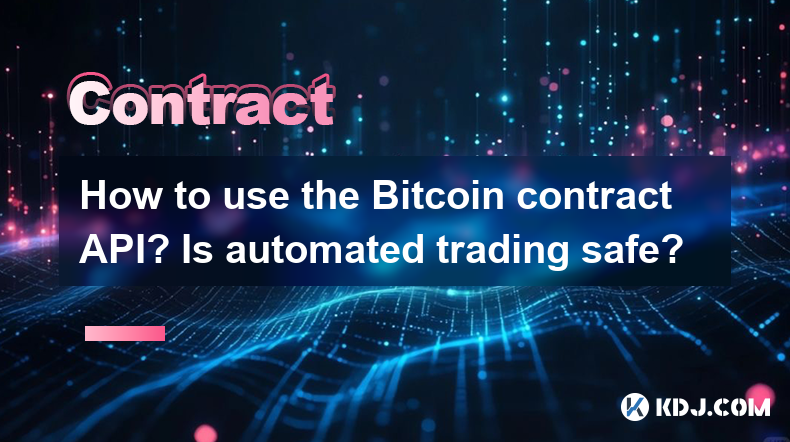-
 bitcoin
bitcoin $87959.907984 USD
1.34% -
 ethereum
ethereum $2920.497338 USD
3.04% -
 tether
tether $0.999775 USD
0.00% -
 xrp
xrp $2.237324 USD
8.12% -
 bnb
bnb $860.243768 USD
0.90% -
 solana
solana $138.089498 USD
5.43% -
 usd-coin
usd-coin $0.999807 USD
0.01% -
 tron
tron $0.272801 USD
-1.53% -
 dogecoin
dogecoin $0.150904 USD
2.96% -
 cardano
cardano $0.421635 USD
1.97% -
 hyperliquid
hyperliquid $32.152445 USD
2.23% -
 bitcoin-cash
bitcoin-cash $533.301069 USD
-1.94% -
 chainlink
chainlink $12.953417 USD
2.68% -
 unus-sed-leo
unus-sed-leo $9.535951 USD
0.73% -
 zcash
zcash $521.483386 USD
-2.87%
How to use the Bitcoin contract API? Is automated trading safe?
The Bitcoin contract API enables developers to create and manage smart contracts on the Bitcoin blockchain, while automated trading safety depends on platform security and algorithm quality.
May 01, 2025 at 11:21 pm

In the world of cryptocurrency, understanding how to use the Bitcoin contract API and whether automated trading is safe are crucial topics for traders and developers alike. This article will delve into the specifics of using the Bitcoin contract API, providing a detailed guide on its implementation, and then explore the safety aspects of automated trading within the cryptocurrency sphere.
Understanding the Bitcoin Contract API
The Bitcoin contract API is a tool that allows developers to interact with the Bitcoin blockchain programmatically. This API enables the creation, management, and execution of smart contracts on the Bitcoin network. Smart contracts are self-executing contracts with the terms of the agreement directly written into code, which automatically enforce and execute the terms of a contract between parties.
To use the Bitcoin contract API, you need to understand its basic components and functionalities. The API typically includes endpoints for creating transactions, managing addresses, and querying blockchain data. It's essential to have a solid grasp of Bitcoin's scripting language and the underlying blockchain technology to effectively use this API.
Setting Up the Bitcoin Contract API
Before you can start using the Bitcoin contract API, you need to set up your development environment. Here's how you can do it:
- Install a Bitcoin node: You'll need to run a full Bitcoin node to interact with the blockchain. This can be done by downloading and installing Bitcoin Core, the reference implementation of the Bitcoin protocol.
- Set up a development environment: Choose a programming language that supports Bitcoin development, such as Python or JavaScript. Install the necessary libraries and tools, such as
bitcoinlibfor Python orbitcoinjs-libfor JavaScript. - Connect to the Bitcoin node: Use the API provided by your Bitcoin node to connect your development environment to the blockchain. This typically involves setting up a connection to the node's RPC (Remote Procedure Call) interface.
Creating and Managing Smart Contracts
Once your environment is set up, you can start creating and managing smart contracts using the Bitcoin contract API. Here's a step-by-step guide:
- Define the contract: Write the smart contract in Bitcoin's scripting language. This involves defining the conditions under which the contract will execute and the actions it will take.
- Create a transaction: Use the API to create a transaction that includes the smart contract. This transaction will be broadcast to the Bitcoin network and, once confirmed, will deploy the contract on the blockchain.
- Manage the contract: Use the API to interact with the deployed contract. This can include sending funds to the contract, triggering its execution, or querying its state.
Executing Smart Contracts
Executing a smart contract on the Bitcoin network involves sending a transaction that meets the conditions specified in the contract. Here's how you can do it:
- Prepare the transaction: Use the API to create a transaction that satisfies the conditions of the smart contract. This might involve signing the transaction with the required private keys.
- Broadcast the transaction: Send the transaction to the Bitcoin network using the API. Once the transaction is confirmed, the smart contract will execute automatically.
- Verify the execution: Use the API to query the blockchain and verify that the smart contract has executed as expected.
Is Automated Trading Safe?
Automated trading, also known as algorithmic trading, involves using computer programs to execute trades based on predefined criteria. In the context of cryptocurrencies, automated trading can be used to trade Bitcoin and other digital assets. The safety of automated trading depends on several factors.
Security of the trading platform: The safety of automated trading largely depends on the security of the platform you're using. Choose a reputable exchange with strong security measures, such as two-factor authentication and cold storage for funds.
Quality of the trading algorithm: The effectiveness and safety of automated trading also depend on the quality of the trading algorithm. A well-designed algorithm can help you make profitable trades, but a poorly designed one can lead to significant losses.
Risk management: Implementing proper risk management strategies is crucial for safe automated trading. This includes setting stop-loss orders, diversifying your portfolio, and not investing more than you can afford to lose.
Monitoring and maintenance: Automated trading systems require regular monitoring and maintenance. Keep an eye on your trades and be prepared to intervene if something goes wrong. Regularly update your trading algorithms to adapt to changing market conditions.
Using the Bitcoin Contract API for Automated Trading
The Bitcoin contract API can be used to implement automated trading strategies on the Bitcoin network. Here's how you can do it:
- Develop a trading algorithm: Write a trading algorithm that uses the Bitcoin contract API to interact with the blockchain. This algorithm should define the conditions under which trades will be executed.
- Deploy the algorithm: Use the API to deploy the trading algorithm on the Bitcoin network. This involves creating and broadcasting transactions that execute the algorithm's trades.
- Monitor and adjust: Continuously monitor the performance of your automated trading system and make adjustments as needed. Use the API to query the blockchain and gather data that can inform your trading decisions.
Frequently Asked Questions
Q: Can I use the Bitcoin contract API to create tokens on the Bitcoin network?A: No, the Bitcoin contract API does not support the creation of tokens. Bitcoin's scripting language is not designed for token creation, and the network does not have the necessary infrastructure to support tokens. If you need to create tokens, you should consider using a blockchain platform like Ethereum, which is designed for this purpose.
Q: How can I ensure the privacy of my transactions when using the Bitcoin contract API?A: To ensure the privacy of your transactions, you can use techniques like coin mixing or CoinJoin. These methods combine your transactions with those of other users, making it difficult to trace the origin and destination of your funds. Additionally, consider using a Bitcoin wallet that supports privacy features, such as Wasabi Wallet.
Q: What are the common pitfalls to avoid when using the Bitcoin contract API for automated trading?A: Common pitfalls include not properly testing your trading algorithm, failing to implement adequate risk management strategies, and neglecting to monitor and maintain your system. To avoid these pitfalls, thoroughly test your algorithm in a simulated environment before deploying it on the live network, implement strict risk management rules, and regularly monitor and update your system.
Q: Are there any regulatory considerations I should be aware of when using the Bitcoin contract API for automated trading?A: Yes, regulatory considerations vary by jurisdiction and can impact your ability to use the Bitcoin contract API for automated trading. Some countries have strict regulations on cryptocurrency trading and may require you to obtain a license or comply with specific reporting requirements. It's essential to research and comply with the regulations in your jurisdiction before engaging in automated trading.
Disclaimer:info@kdj.com
The information provided is not trading advice. kdj.com does not assume any responsibility for any investments made based on the information provided in this article. Cryptocurrencies are highly volatile and it is highly recommended that you invest with caution after thorough research!
If you believe that the content used on this website infringes your copyright, please contact us immediately (info@kdj.com) and we will delete it promptly.
- Gold's Bearish Divergence Sparks Shift: Metals Sentiment Cools Amidst Bitcoin Rotation Hopes
- 2025-12-30 06:30:01
- Filecoin's Asymmetric Bet: Crypto's Data Storage Darling or a Lopsided Gamble?
- 2025-12-30 06:40:01
- Bitcoin's Big Apple Quiet: Calm Before Big Moves, Or Just The Beginning?
- 2025-12-30 04:00:07
- Bitcoin's Rally Fueled by Spot Demand Amidst Thin Holiday Trading and Shifting Derivatives
- 2025-12-30 04:10:02
- IFAB's Penalty Shootout Rule Under Scrutiny: Does a Flaw Fix Lead to Fairer Play?
- 2025-12-30 03:55:01
- Harris Evans Launches Coin and Seed Wealth Management, Empowering Clients with a Personalized Approach
- 2025-12-30 03:55:01
Related knowledge

What is the best time of day to trade crypto futures?
Dec 26,2025 at 05:40pm
Market Liquidity Patterns1. Liquidity tends to peak during overlapping institutional trading hours across major financial centers. The window between ...

What is a "naked" short position in crypto?
Dec 29,2025 at 05:20am
Definition and Mechanics1. A 'naked' short position in crypto refers to the act of selling a digital asset short without first borrowing or arranging ...

What is the difference between a limit order in the order book and a stop-limit order?
Dec 27,2025 at 08:00pm
Order Book Mechanics1. A limit order appears directly in the order book as a visible bid or ask at a specified price level. 2. It remains active until...

How to use Fibonacci retracement to find entry and exit points?
Dec 24,2025 at 05:00pm
Fibonacci Retracement Basics1. Fibonacci retracement is a technical analysis tool derived from the Fibonacci sequence, where each number is the sum of...

What is the risk of ruin and how to calculate it?
Dec 29,2025 at 04:59pm
Market Volatility Patterns1. Bitcoin’s price movements often exhibit sharp intraday swings exceeding 5% during low-liquidity windows, especially betwe...

What are the pros and cons of using a trading bot for futures?
Dec 27,2025 at 09:59pm
Automated Execution Efficiency1. Trading bots process market data and execute orders in milliseconds, far surpassing human reaction time during volati...

What is the best time of day to trade crypto futures?
Dec 26,2025 at 05:40pm
Market Liquidity Patterns1. Liquidity tends to peak during overlapping institutional trading hours across major financial centers. The window between ...

What is a "naked" short position in crypto?
Dec 29,2025 at 05:20am
Definition and Mechanics1. A 'naked' short position in crypto refers to the act of selling a digital asset short without first borrowing or arranging ...

What is the difference between a limit order in the order book and a stop-limit order?
Dec 27,2025 at 08:00pm
Order Book Mechanics1. A limit order appears directly in the order book as a visible bid or ask at a specified price level. 2. It remains active until...

How to use Fibonacci retracement to find entry and exit points?
Dec 24,2025 at 05:00pm
Fibonacci Retracement Basics1. Fibonacci retracement is a technical analysis tool derived from the Fibonacci sequence, where each number is the sum of...

What is the risk of ruin and how to calculate it?
Dec 29,2025 at 04:59pm
Market Volatility Patterns1. Bitcoin’s price movements often exhibit sharp intraday swings exceeding 5% during low-liquidity windows, especially betwe...

What are the pros and cons of using a trading bot for futures?
Dec 27,2025 at 09:59pm
Automated Execution Efficiency1. Trading bots process market data and execute orders in milliseconds, far surpassing human reaction time during volati...
See all articles










































































